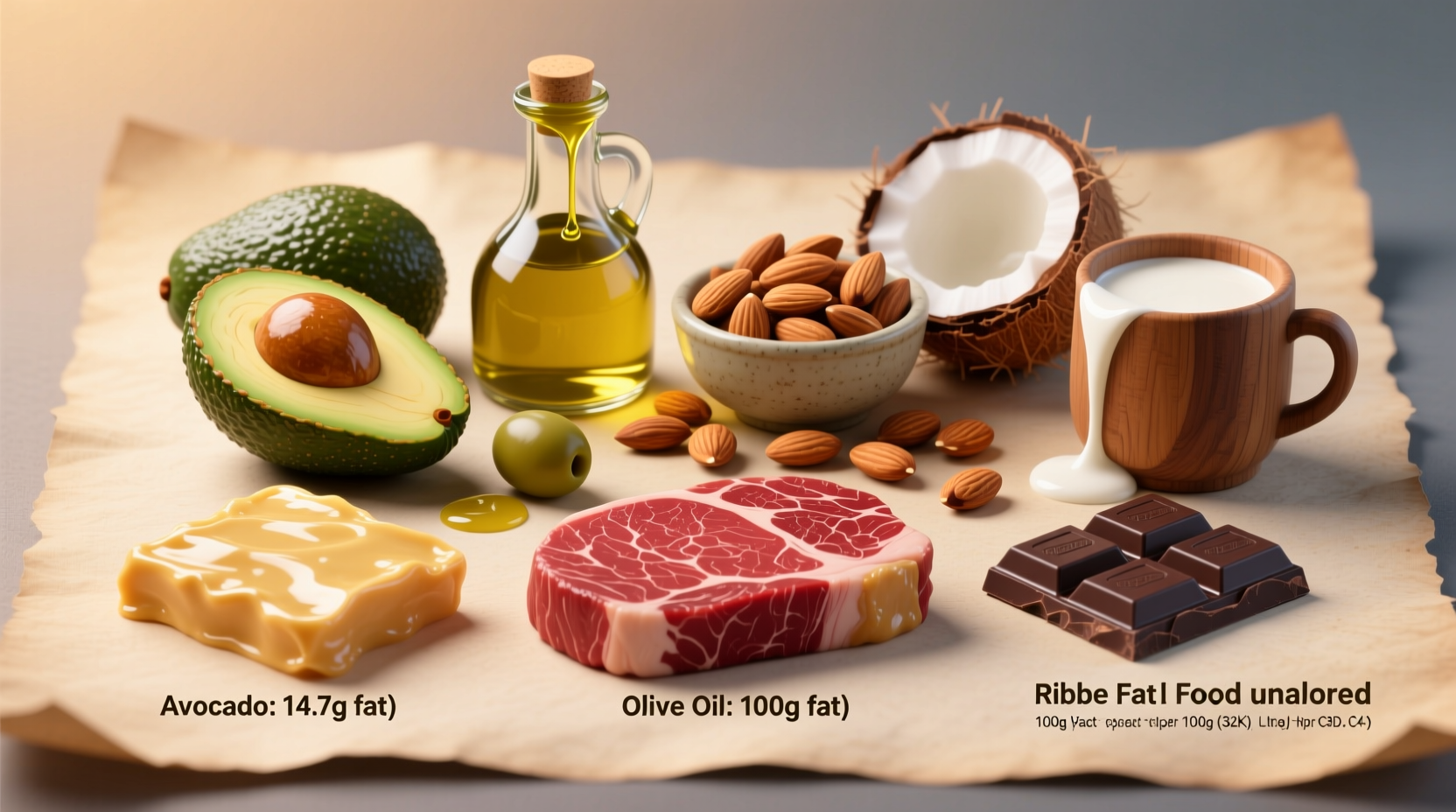Understanding which foods are high in fat matters for balanced nutrition. While fats have been unfairly demonized in the past, modern nutrition science recognizes that certain high-fat foods are essential for absorbing vitamins, supporting brain health, and maintaining cell function. The key distinction lies between beneficial unsaturated fats found in whole foods versus problematic trans fats and excessive saturated fats in processed options.
Healthy High-Fat Foods Worth Including
Not all high-fat foods deserve equal consideration. The following nutrient-dense options deliver healthy fats alongside valuable vitamins, minerals, and fiber. These should form the foundation of your high-fat food choices:
| Food | Fat Content (per 100g) | Primary Fat Type | Additional Benefits |
|---|---|---|---|
| Avocado | 15g | Monounsaturated | Rich in potassium, fiber, vitamins K, E, C |
| Almonds | 49g | Monounsaturated | High in vitamin E, magnesium, plant protein |
| Chia Seeds | 31g | Omega-3 (ALA) | Excellent fiber source, calcium, antioxidants |
| Salmon | 13g | Omega-3 (EPA/DHA) | Complete protein, vitamin D, selenium |
| Olive Oil | 100g | Monounsaturated | Polyphenols with anti-inflammatory properties |
This nutritional comparison reveals why certain high-fat foods earn their place in balanced diets. According to the USDA FoodData Central, these whole food sources deliver fats alongside complementary nutrients that processed high-fat options lack. The American Heart Association emphasizes that replacing saturated fats with unsaturated alternatives can significantly improve cardiovascular health markers.
High-Fat Foods Requiring Moderation
Some high-fat foods contain predominantly saturated fats or harmful trans fats that warrant careful consumption. While occasional enjoyment is fine, regular overconsumption may impact long-term health:
- Fried foods: French fries, fried chicken, and doughnuts absorb significant oil during cooking, often containing unstable fats that oxidize at high temperatures
- Processed meats: Bacon, sausages, and hot dogs frequently combine high saturated fat with sodium and preservatives
- Baked goods: Pastries, cookies, and cakes often contain both saturated fats and added sugars
- Full-fat dairy products: While nutrient-dense, butter and certain cheeses deliver concentrated saturated fats
The Dietary Guidelines for Americans 2020-2025 recommend limiting saturated fats to less than 10% of daily calories. For a 2,000-calorie diet, this translates to no more than 22 grams of saturated fat per day. Understanding these boundaries helps make informed choices about which high-fat foods to prioritize.
Understanding Fat Types: What Really Matters
The evolution of nutritional science has dramatically shifted our understanding of dietary fats. In the 1980s and 1990s, all fats were broadly discouraged, leading to the proliferation of low-fat processed foods often loaded with added sugars. Current research, including landmark studies published in Circulation, recognizes the critical distinction between fat types:
- Monounsaturated fats: Found in avocados, olive oil, and most nuts. Associated with improved cholesterol levels and reduced heart disease risk
- Polyunsaturated fats: Include omega-3 and omega-6 fatty acids. Essential fats our bodies cannot produce, crucial for brain function and inflammation regulation
- Saturated fats: Primarily from animal sources and tropical oils. Should be consumed in moderation according to current guidelines
- Trans fats: Mostly artificial fats created through hydrogenation. Banned in many countries due to strong links with heart disease

Practical Guidelines for Daily Fat Intake
Determining your ideal fat intake depends on several factors including age, activity level, and health goals. The Institute of Medicine recommends that adults consume 20-35% of daily calories from fat. For most people following a 2,000-calorie diet, this translates to 44-78 grams of total fat daily.
Here's how to practically incorporate high-fat foods:
- Add 1/4 avocado to your morning eggs instead of processed breakfast meats
- Use olive oil as your primary cooking fat for temperatures under 375°F
- Enjoy a small handful (about 1 ounce) of nuts as a satisfying snack
- Include fatty fish like salmon in your meals at least twice weekly
- Choose full-fat Greek yogurt over low-fat versions with added sugars
Research from the National Institutes of Health indicates that Mediterranean-style diets rich in healthy fats correlate with better long-term health outcomes compared to low-fat approaches. The key is focusing on whole food sources rather than isolated fats.
Creating Balance: High-Fat Foods in Context
High-fat foods don't exist in isolation within your diet. Their impact depends significantly on what they replace and what accompanies them. Adding avocado to a salad of vegetables enhances nutrient absorption, while consuming fried foods instead of vegetables represents a less beneficial choice.
Consider these practical applications:
- For active individuals: Healthy fats support sustained energy and recovery. Athletes often benefit from slightly higher fat intake (up to 35% of calories)
- For weight management: Fats increase satiety. Replacing refined carbohydrates with healthy fats often reduces overall calorie intake naturally
- For heart health: Prioritize omega-3 rich foods like fatty fish while limiting processed sources of saturated fats
- For brain function: The brain is composed of nearly 60% fat. Adequate healthy fat intake supports cognitive performance
Remember that individual responses to dietary fat vary. Some people thrive with higher fat intake, while others feel better with moderate amounts. Pay attention to how your body responds to different high-fat foods as you build your personalized approach.
Key Takeaways
Not all high-fat foods are created equal. Whole food sources like avocados, nuts, seeds, and fatty fish deliver beneficial fats alongside valuable nutrients. Processed high-fat options often contain less healthy fat profiles combined with other problematic ingredients. By understanding fat types and practicing mindful consumption, you can harness the nutritional benefits of high-fat foods while minimizing potential drawbacks. Focus on quality sources, appropriate portions, and how these foods fit within your overall dietary pattern for optimal results.











 浙公网安备
33010002000092号
浙公网安备
33010002000092号 浙B2-20120091-4
浙B2-20120091-4